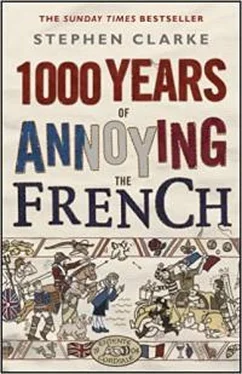Стефан Кларк - 1000 Years of Annoying the French
Здесь есть возможность читать онлайн «Стефан Кларк - 1000 Years of Annoying the French» весь текст электронной книги совершенно бесплатно (целиком полную версию без сокращений). В некоторых случаях можно слушать аудио, скачать через торрент в формате fb2 и присутствует краткое содержание. ISBN: , Издательство: Transworld Digital, Жанр: Старинная литература, на английском языке. Описание произведения, (предисловие) а так же отзывы посетителей доступны на портале библиотеки ЛибКат.
- Название:1000 Years of Annoying the French
- Автор:
- Издательство:Transworld Digital
- Жанр:
- Год:неизвестен
- ISBN:9781407067629
- Рейтинг книги:3 / 5. Голосов: 1
-
Избранное:Добавить в избранное
- Отзывы:
-
Ваша оценка:
- 60
- 1
- 2
- 3
- 4
- 5
1000 Years of Annoying the French: краткое содержание, описание и аннотация
Предлагаем к чтению аннотацию, описание, краткое содержание или предисловие (зависит от того, что написал сам автор книги «1000 Years of Annoying the French»). Если вы не нашли необходимую информацию о книге — напишите в комментариях, мы постараемся отыскать её.
1000 Years of Annoying the French — читать онлайн бесплатно полную книгу (весь текст) целиком
Ниже представлен текст книги, разбитый по страницам. Система сохранения места последней прочитанной страницы, позволяет с удобством читать онлайн бесплатно книгу «1000 Years of Annoying the French», без необходимости каждый раз заново искать на чём Вы остановились. Поставьте закладку, и сможете в любой момент перейти на страницу, на которой закончили чтение.
Интервал:
Закладка:
Discord over Concorde
It seems hardly credible that while de Gaulle was trying to shoot Britain down in flames, the Brits and the French were co-operating – or at least trying to – on the development of Concorde.
They had been working individually on supersonic aircraft ever since the war. France was developing a small fast plane for routes to its African colonies. The British Aircraft Corporation, meanwhile, was drawing blueprints for a wedge-shaped transatlantic jet – basically, the future Concorde. Soon, though, the British project was soaring over budget rather than over the clouds, and the government demanded that outside funding be found. Hoping that a bit of technology-sharing might lubricate their entry into the Common Market, Britain turned to France.
The French were unwilling at first, but realized that they needed help building a supersonic engine, and agreed. Even so, mutual suspicion was so great that the contract became a political treaty rather than a purely commercial deal, with Britain demanding prohibitive cancellation penalties from the French state to stop it pulling out later.
In 1962, work was started on two projects – the British transatlantic plane and France’s smaller version. It soon became clear, however, that no one would want to buy the French plane, and it was dropped.
Arguments also raged about the name of the aeroplane. The French wanted Concorde, but Harold Macmillan held out for the British spelling, Concord, and finally got his way. It was his one minor victory over de Gaulle, and it was to be short-lived – in 1967, when the first prototype was unveiled in Toulouse, Britain’s Minister for Technology, Tony Benn, announced that the plane would be called Concorde. The final E, he said, stood for Excellence, Europe, Entente and England. (When a Scot wrote to him pointing out that the nose cone was made north of the border, Benn added that the E also stood for Écosse, the French for Scotland.)
Two prototypes were made – one in France, one in the UK – and the French beat the Brits into the air by a month, sending their version supersonic on 2 March 1969. The planes even got royal approval when the Queen flew to Toulouse in the British Concorde. Unfortunately, though, the new Anglo-French invention was a commercial flop. This was partly because of the 1973 oil crisis – Concorde used two tons of fuel just taxiing to the runway – but mainly because the Americans banned the planes from causing supersonic booms in their airspace, a move often interpreted as envy that the Europeans had achieved something they hadn’t. Consequently, only sixteen Concordes were ever built, and the Brits cursed themselves for insisting on those pull-out penalties.
Technically, the planes were a huge success. Pilots all agreed that they were great fun to fly, and they delivered on all their promises. The flight time from London to New York was more than halved, to only 210 minutes, barely time for lunch and a film. And while the Concordes were in the air, they were elegant symbols of what the Brits and French, despite all their differences and constant squabbling, could achieve if they co-operated. It just seems a shame that the story came plummeting to its tragic end in July 2000, when a Concorde crashed on take-off – from (ironically) Charles de Gaulle airport in Paris.
Au revoir to the Americans
When de Gaulle agreed to work with the Brits on Concord(e) in 1962, it was no doubt because he saw it as an anti-American project. Throughout his post-war career, he kept up a steady campaign of Yank-bashing, saying most famously that Vietnam was a ‘detestable war, since it leads a large nation to ravage a small one’, thereby conveniently forgetting France’s exploits in the same country.
In 1966, he saw the perfect opportunity to poke his political tongue out at America and Britain at the same time.
He had started to cause trouble in NATO almost immediately he returned to power in 1958, grumbling that Britain and the US were plotting together to control the organization’s policy, and provoking them by asking NATO to back his colonial war in Algeria. In 1959, he had ejected all foreign nuclear weapons from French soil, forcing the Americans to move theirs to Britain and Germany, and then in 1962 he removed his navy from NATO command. His posturing for independence came to its logical climax when in 1966 he ordered all foreign troops out of France, arguing that in the event of war, he would not let French soldiers bow to American command as they had been forced to do in World War Two.
The way de Gaulle announced his new policy has gone down in history.
Apparently the Général phoned the American President, Lyndon Johnson, to tell him that France was opting out of NATO, and that consequently all American military personnel had to be removed from French soil.
Taking part in the conference call was Dean Rusk, the US Secretary of State, and Johnson told Rusk to reply: ‘Does that include those buried in it?’
1968: Parisian students discover sex
Two years later, history caught up with de Gaulle.
In May 1968, Paris students took to the barricades. Today, this revolt is remembered in France as a modern version of 1789, an uprising by idealistic youth against the tyrannical establishment. In fact, though, it all started as a bit of posturing about sex.
In March, the students at a new campus in Nanterre, a suburb just west of Paris, went on strike because of poor living conditions. The campus was a barely finished building site, and combined all the impersonality of a French nouvelle ville with the mud of the Somme trenches and a ridiculously undersized canteen. What was worse, male and female students were not allowed to mix in the halls of residence – in other words, sleepovers were forbidden. In protest, the frustrated students occupied the administration buildings.
Hearing about the reasons for the sit-in, de Gaulle’s Minister of Education stirred things up by telling the students to cool their ardour in their new swimming pool (which sounds as though it wasn’t heated). He also ordered the Nanterre campus temporarily shut down, at which point the students took their grievances to the Sorbonne in central Paris and managed to turn disgruntlement about the single-sex dorms into a call for national revolution.
The rector of the Sorbonne panicked and called in the riot police, who cracked a few heads as they cleared the building. A protest march against this over-reaction provoked an even greater over-reaction, especially since the police violence was filmed and photographed as no French demonstration ever had been before. Soon events had spiralled out of control in typical French style, with first the students and then the workers taking to the streets all over the country.
By mid-May ten million workers were on strike, and the students’ cause had been sidetracked by the unions. The call for revolution had turned into a call for a pay rise.
De Gaulle was seriously scared, though. During the protests, he took refuge on a French army base in Germany, where he discussed military intervention, and only re-emerged once things had calmed down. Ironically, the calming was done by the unions, who needed to prove that they, and not the middle-class students, were the ones who would call for revolution if and when it was required.
What French people forget is that despite all these tumultuous events, when the country went to the polls in June 1968 (to elect Members of Parliament, not a new president), the Gaullists won a spectacular victory, taking more than two-thirds of the seats. The supposed revolution had only made the people want to strengthen the status quo.
De Gaulle’s veneer of invulnerability had been dented, however, and he was forced to resign the following year after a failed referendum to reform local government and the Senate, the upper house of Parliament. Rather unwisely, he had promised to quit if the result of the poll was a ‘no’ – always a mistake for a leader who has been in power for ten years (except if they are controlling the ballot count, of course).
Читать дальшеИнтервал:
Закладка:
Похожие книги на «1000 Years of Annoying the French»
Представляем Вашему вниманию похожие книги на «1000 Years of Annoying the French» списком для выбора. Мы отобрали схожую по названию и смыслу литературу в надежде предоставить читателям больше вариантов отыскать новые, интересные, ещё непрочитанные произведения.
Обсуждение, отзывы о книге «1000 Years of Annoying the French» и просто собственные мнения читателей. Оставьте ваши комментарии, напишите, что Вы думаете о произведении, его смысле или главных героях. Укажите что конкретно понравилось, а что нет, и почему Вы так считаете.












